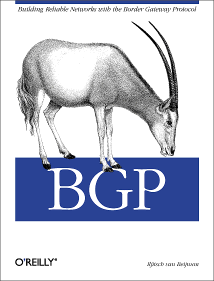
|

|

|
|
Home ·
BGP Expert Test ·
What is BGP? ·
BGP Vendors ·
Links ·
Archives ·
Books ·
My New BGP Book | ||
2008 IPv4 Address Use ReportAs of January first, 2009, the number of unused IPv4 addresses is 925.58 million. On January 1, 2008, it was 1122.85 million. So in 2008, 197.27 million addresses were used up. With 3706.65 million usable addresses, this means that 75.3% of the available IPv4 addresses are in some kind of use, up from 69.7% a year ago. So the depletion of the IPv4 address reserves is continuing in much the same way as in previous years:
Date Addresses free Used up 2006-01-01 1468.61 M 2007-01-01 1300.65 M 167.96 M 2008-01-01 1122.85 M 177.80 M (with return of 16.78 M to IANA) 2009-01-01 925.58 M 197.27 M These figures are derived from from the Internet Assigned Numbers Authority's IPv4 Global Unicast Address Assignments page and the records published on the FTP servers of the five Regional Internet Registries (RIRs): AfriNIC, which gives out address space in Africa, APNIC (Asia-Pacific region), ARIN (North America), LACNIC (Latin American and the Caribbean) and the RIPE NCC (Europe, the former Soviet Union and the Middle East). The IANA list shows the status of all 256 blocks of 16777216 addresses identified by the first 8-bit number in the IPv4 address. (Note that the file is in a somewhat different format than in previous years.) The RIR data indicates how much address space the RIRs have delegated to internet service providers (and sometimes end-users).
Delegated Blocks +/- 2008 Addresses Used Available to/status (in millions) AfriNIC 2 33.55 9.18 24.37 APNIC 30 +4 503.32 454.36 48.96 ARIN 31 +4 520.09 446.06 74.03 LACNIC 6 100.66 68.88 31.78 RIPE NCC 26 436.21 423.65 12.56 LEGACY 92 +1 1543.50 1363.29 180.21 UNALLOCATED 34 -9 570.43 570.43 Totals 221 3707.76 2765.42 942.34 The difference between the 942.34 million free addresses here and 925.58 million earlier is explained by the fact that the 43.0.0.0/8 legacy block shows up as delegated in the IANA list, but not in the APNIC delegation records. In previous years, 7.0.0.0/8 didn't show up in the IANA records but it did in the ARIN records. This has now been fixed, hence the increase in legacy delegations. No legacy blocks were returned to IANA in 2008. The total number of available addresses is slightly higher than the previously mentioned figure at 3707.76 million because the table above includes 172.16.0.0/12 and 192.168.0.0/16, which are set aside for private use. Networks 0.0.0.0/8 and 127.0.0.0/8 aren't usable because of special uses and 10.0.0.0/8 is also set aside for private use. 224 - 239 are multicast addresses, and 240 - 255 is class E, which is "reserved" for future use. If the class E space could be used, it would increase the available address space by 268 million addresses. The past two years, this has been a topic of hot debate in the IETF and elsewhere. The problem is that almost all operating systems need modification to be able to use class E addresses, and a good part of the installed base of devices connected to the internet must be considered unupgradable. The 2781.07 million addresses currently in use aren't very evenly distributed over the countries in the world. The current top 15 is:
2009-01-01 2008-01-01 increase Country
1 - US 1458.21 M 1408.15 M 4% United States
2 (3) CN 181.80 M 135.31 M 34% China
3 (2) JP 151.56 M 141.47 M 7% Japan
4 - EU 120.29 M 120.35 M 0% Multi-country in Europe
5 - GB 86.31 M 83.50 M 3% United Kingdom
6 (7) DE 81.75 M 72.46 M 13% Germany
7 (6) CA 74.49 M 73.20 M 2% Canada
8 - FR 68.04 M 67.79 M 0% France
9 - KR 66.82 M 58.86 M 14% Korea
10 - AU 36.26 M 33.43 M 8% Australia
11 (12) BR 29.75 M 23.46 M 27% Brazil
12 (11) IT 29.64 M 24.04 M 23% Italy
13 (16) TW 24.01 M 19.83 M 21% Taiwan
14 (18) RU 23.18 M 17.01 M 36% Russia
15 (14) ES 21.67 M 20.42 M 6% Spain
In 2008, the United States was again the biggest user of new address space with no less than 50 million addresses added to the 1.4 billion they already had at the beginning of the year. China is a close second with 46.50 million new addresses. There is no clear trend in the growth percentages. A few countries like France and the UK show very modest growth, while other countries with a large installed base like Germany and Korea saw double digit growth percentages. And in addition to China, Brazil, Taiwan and Russia, but also Italy, are catching up. The US now holds 52.4% of the IPv4 address space in use. The total for the top 15 excluding the US is 35.8%. The rest of the world gets the remaining 327.23 million addresses, or 11.8%. The size of address blocks given out was increasing until 2005, but now shows a downturn. The table below shows the number of delegations for a certain range of block sizes (equal or higher than the first, lower than the second value).
2002 2003 2004 2005 2006 2007 2008
< 1000 547 745 1022 1309 1507 1830 1896
1000 - 8000 897 1009 1516 1891 2265 2839 3235
8000 - 64k 822 1014 1100 1039 1192 1015 1129
64k - 500k 163 215 404 309 419 395 410
500k - 2M 29 46 61 60 57 62 82
> 2M 5 6 7 18 17 24 18
In millions of addresses:
2002 2003 2004 2005 2006 2007 2008
< 1000 0.18 0.25 0.35 0.44 0.51 0.63 0.65
1000 - 8000 3.23 3.45 4.49 5.07 5.83 6.93 7.75
8000 - 64k 11.35 14.00 15.99 15.46 18.01 15.67 17.40
64k - 500k 20.28 25.51 42.01 34.23 50.86 50.83 52.58
500k - 2M 21.30 31.98 44.63 41.63 46.69 45.50 57.41
> 2M 12.58 12.58 20.97 68.62 52.43 67.37 54.00
The growth in the smallest and largest categories has been curtailed, but this growth now seems to happen in the second smallest and second largest categories, so the total effect isn't all that different, as indicated by the number of addresses given out per request/delegation:
Year Blocks Addresses (M) Average block size 2000 2794 78.35 28043 2001 2824 88.95 31497 2002 2463 68.93 27985 2003 3035 87.77 28921 2004 4110 128.45 31252 2005 4626 165.45 35765 2006 5457 174.32 31945 2007 6165 186.92 30320 2008 6770 189.79 28035 (The numbers of addresses given out are lower here because ARIN often attributes the delegation of new addresses to a previous year, this view doesn't correct for that.) Also see the address use reports for 2005, 2006 and 2007.
|
